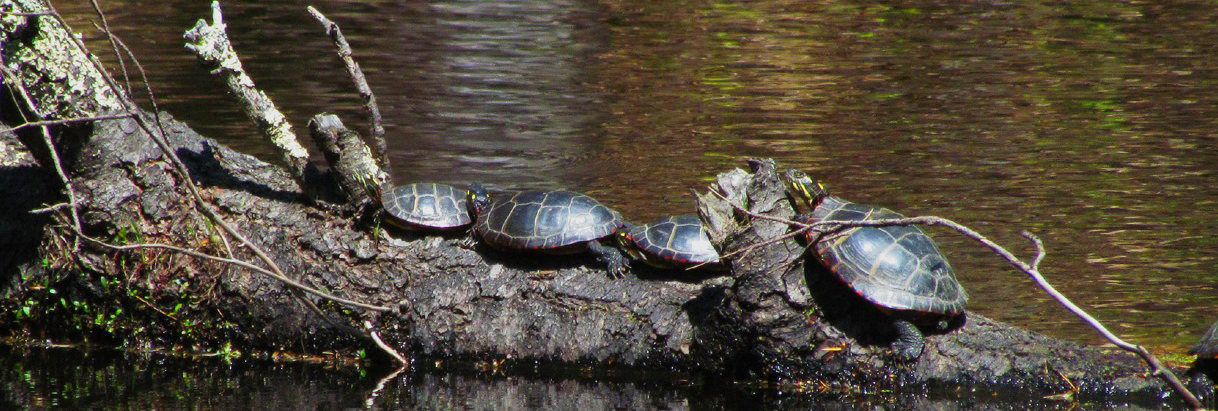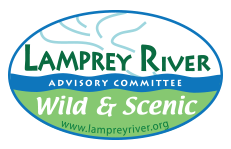TEACHER BACKGROUND-RIVER CURRENT
Background:
Currents in bodies of water are very important to move food, oxygen, and microscopic plants and animals from place to place. Currents help to determine where water animals and plants live. In Betty Meadows, at the headwaters of the Lamprey River, the river is dammed and doesn't have much of a current. Plants with shallow root systems, such as water lilies, live there. Beavers and muskrats build their lodges there. Ducks nest near the water in grassy areas. Elsewhere, the current is fast and plants with longer roots and flexible bodies are found. Where the current is swift and oxygen is plentiful, several fish species build nests and deposit their eggs in gravel areas. Filter feeders, such as fresh water mussels, collect food particles from the moving water that passes over and around them.
In this section, students will calculate the speed or rate of the current at two sites, dividing the distance water flows (20 meters) by the time it takes to do it. Rate = distance /time.
Preparation:
Have the students mark a 20-meter rope in meters. Use it first in the classroom as a measuring device for the pre-field trip practice and later in the field. They will also need several oranges or apples to float in the river and a volleyball or basketball to use in the pre-field experiment.
Discussion:
What is a current? How do you determine the rate or speed of a current?
How do currents affect animals?
What adaptations do plants have to help them live in strong currents?
CHAPERONE CHEAT SHEET: RIVER CURRENT
Students line up near the edge of the river. One student holds the stopwatch, one student stands at either end of a 20 meter rope, and one student has an apple and stands upstream of the other students. (If the area is too small, fold the rope in half and then double the time and the distance.
Have the student with the apple throw it into the river. As it passes the first student, have that student yell, “Start!”. Instruct the student with the stopwatch to start timing. As the apple passes by the end of the rope, have that student yell, “Stop!”. Instruct the student with the stopwatch to stop timing. Record the site number and time on the data sheet. Remember to double the time if the rope needed to be folded in half.
Change jobs and have the students repeat the process.
STUDENT EXPERIMENT: DETERMINING THE RIVER'S CURRENT
Overview:
In this experiment, your team will calculate the current, or how fast the water in the Lamprey River is flowing. Scientists are interested in knowing the current, because it helps to determine what kinds of plants and animals can live there. If the water is moving fast, plants must have a strong root system and strong leaves that let the water pass over or through them without causing damage. Fast currents are attractive to animals that need a lot of oxygen. They are either strong swimmers, such as trout, or they can burrow in the bottom or hold tightly to a rock or other solid surface. If the water is moving slowly, floating plants with large leaves and a weak root system can live there easily. Animals that can survive low oxygen in the water and sometimes muddy conditions are more commonly found in slow currents.
Focus:
What is the current speed at sites along the Lamprey River and how does it affect animals and plants that live in those different sites. (Try one place where the water moves slowly and one where it is moving faster.)
Materials:
pre-field experiment:
___20-meter rope marked at each meter
___4 balls (basketball or volleyball)
___stopwatch
___data sheet and clipboard or science journals
___pencils
Field experiment:
___20-meter rope marked at each meter
___stopwatch
___items that will float (oranges, apples, or paper boats made by students)
___data sheet and clipboards or science journals
___pencils and pencil sharpener
Procedure:
Pre-field experiment:
1. In a large area such as the gym, hallway, or playground, have two students hold the ends of the 20 meter rope. Name the beginning of the rope Point A and the end B. Explain that the team will use the ball to represent the orange or apple flowing with the river’s current.
2. Have a third team member start the ball rolling along an imaginary line making sure it continues rolling as it passes points A and B.
3. As the ball rolls past A, the team member at A should shout, “Start!"
4. A fourth team member holds a stopwatch and starts timing as the ball passes A.
5. As the ball rolls past Point B the team member at Point B shouts, “Stop."
6. The timer stops the stopwatch and announces to the team the number of seconds the ball took to pass from A to B.
7. Team members record the amount of time in their science journals or data sheets.
8. Repeat the first seven steps 4 times, rotating duties among team members.
9. Convert meters to centimeters by multiplying 20m by 100 cm to get a distance of 2000 cm.
10. Calculate the speed of the ball from Point A to Point B in centimeters per second using the following formula for each time the experiment was conducted: Current rate (speed) =distance divided by time. (r=d/t)
10. Calculate the average speed of the ball. The average speed is the sum of all recorded speeds divided by the number of times the speeds were recorded. Why did we do the experiment several times and average the results?
Field experiment:
1. Determine which way the river is flowing. Designate the upstream end of the 20 meter rope as Point A and the downstream end as Point B.
2. Have one team member stand along the bank at Point A and another at Point B. (In some cases students might have to hold the ends of the rope to make it as straight as possible.) Follow the steps in the pre-field experiment. Repeat twice or more and average the results.

